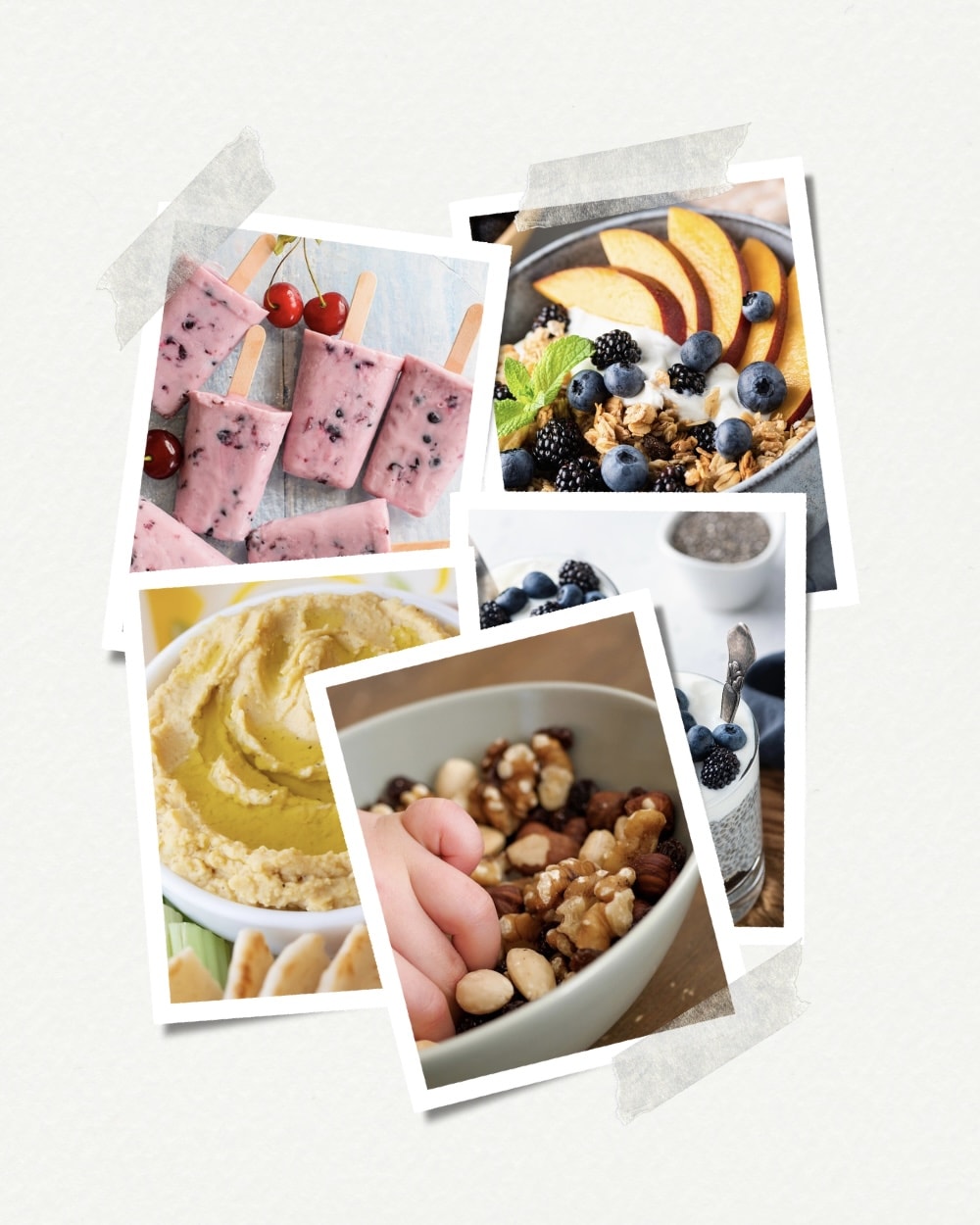
25 High Protein Snacks For Kids
Let’s face it: keeping our kids nourished and satisfied can feel like a never-ending battle. And in today’s fast-paced world, finding healthy and convenient snacks for our little ones can be a daunting task. Well, what if I told you there is a solution to the constant snacking that provides your child with vital nutrients, keeps their energy levels up, and keeps their tummies full for longer? Enter the world of high-protein snacks for kids.
To make things easy for you, I’ve compiled a list of high-protein snacks that even the pickiest eaters will love. From crunchy bites to savory treats, this list of kid-friendly snack ideas will help you meet the protein needs of your child’s diet. With both homemade snacks and store-bought goodies, get ready to make snack time a delightful and nutritious experience for your little ones. So, let’s dive in and discover the best protein-rich snacks for your kiddos!
High Protein Snacks For Kids
Edamame
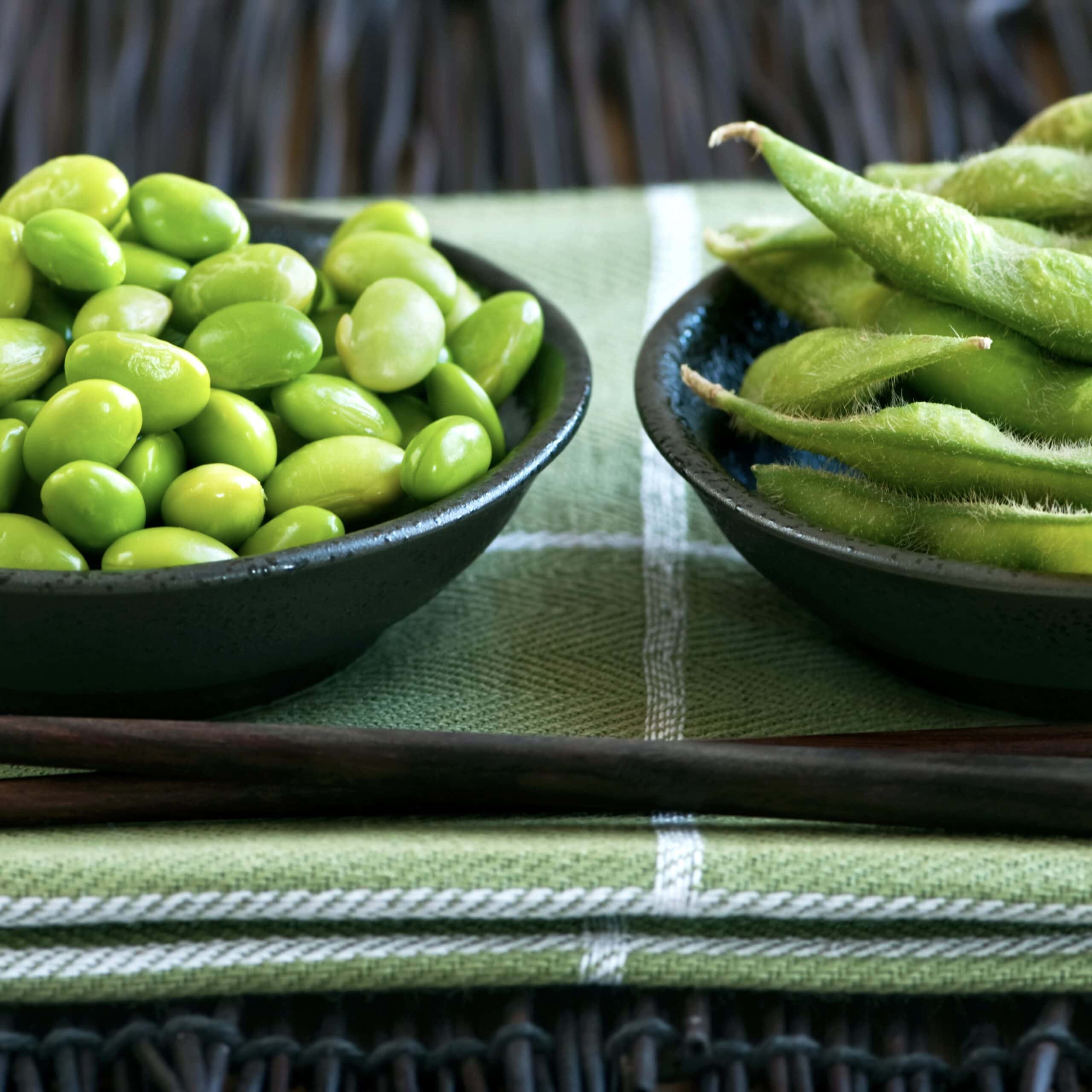
One cup of shelled edamame contains 18.4 grams of protein
Edamame are young green soybeans still in their pods. They are a rich source of plant-based protein that provides all the essential amino acids. They are often enjoyed as a nutritious snack by boiling or steaming the pods and then sprinkling them with salt.
Edamame is typically sold frozen in the pod or shelled, making it very easy to keep your freezer stocked with a few bags. Making them only takes about 10 minutes, and kids stay busy popping out the beans and eating them.
Greek Yogurt With Fruit
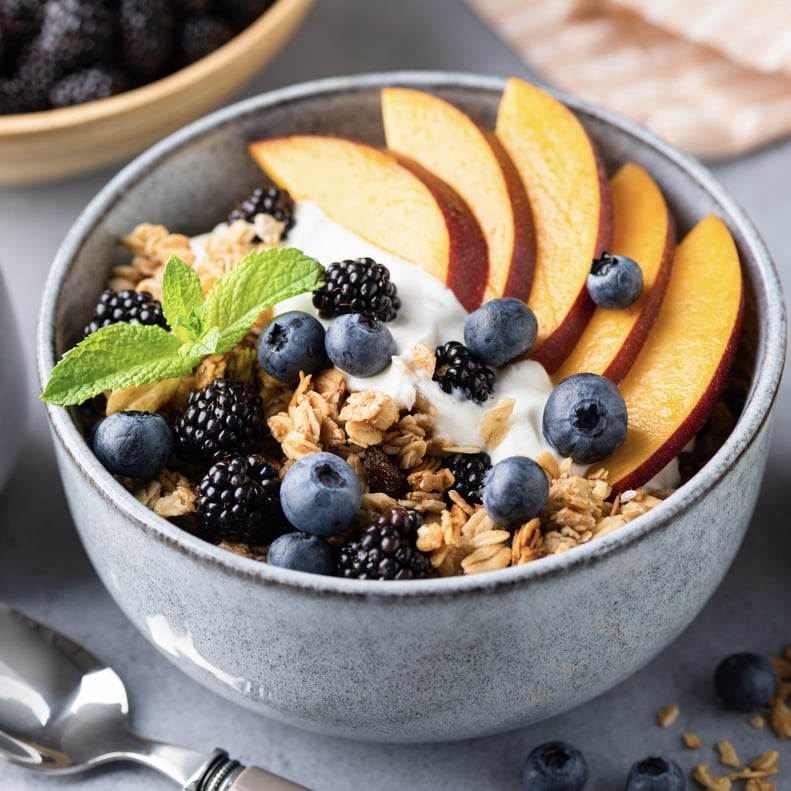
One serving of Greek Yogurt has around 15 grams of protein, but this number will vary depending on the type of Greek yogurt.
The higher protein content in Greek yogurt compared to regular yogurt can help keep you feeling full and satisfied for longer. Yogurt also contains probiotics, which contribute to a healthy balance of gut bacteria, which supports digestion and overall gut health.
When choosing Greek yogurt, opting for varieties without added sugars and artificial ingredients is important. Instead, add fruits like berries or sliced bananas and apples for sweetness and fiber.
- Fage Greek Yogurt: 16g Protein
- Norr Organic Probiotic Skyr: 15g Protein
- Icelandic Provision’s Traditional Skyr: 15g Protein
String Cheese or Cheese Cubes
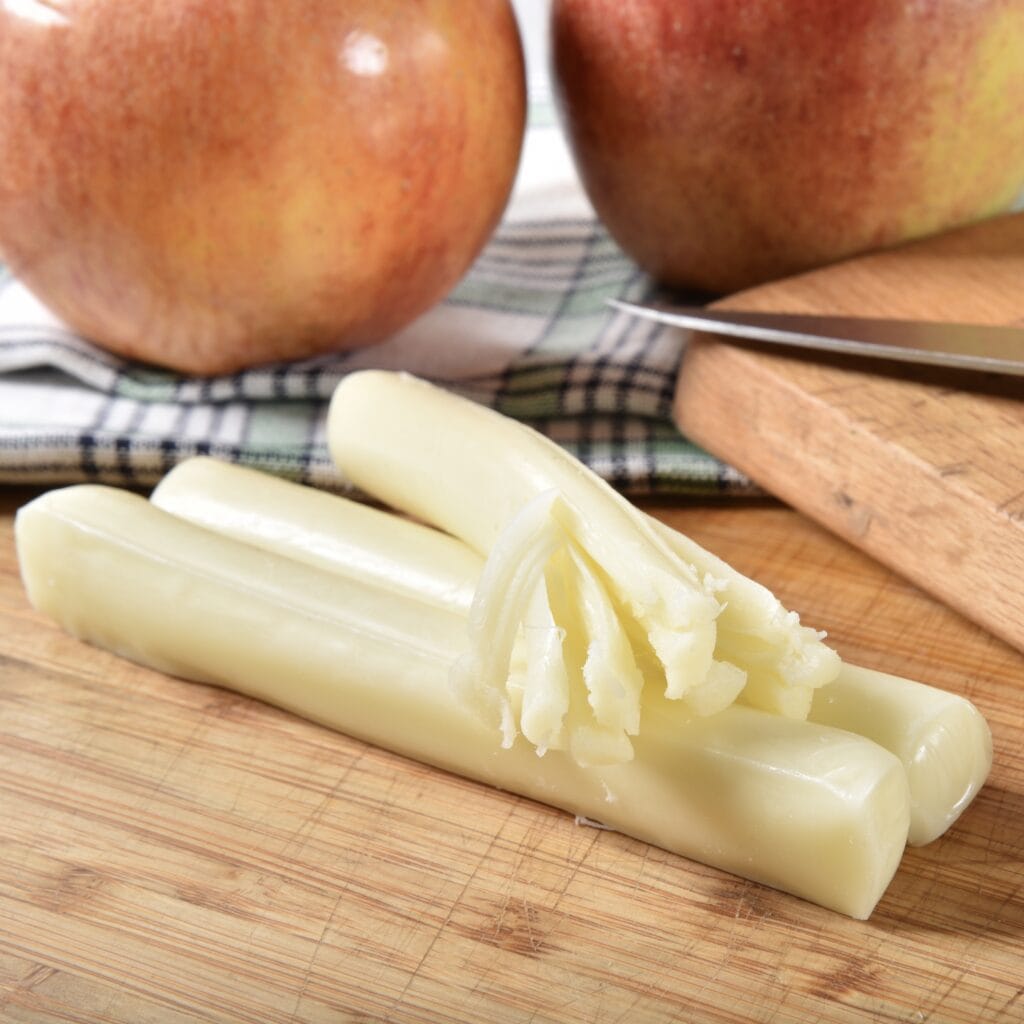
One serving of string cheese has about 7 grams of protein.
I’ve yet to meet a kid who won’t eat a cheese stick. Besides the fact that it tastes good, pulling apart the strings can make it an enjoyable and satisfying snack for kids. The individual packaging and easy-to-pull-apart nature make string cheese a convenient grab-and-go snack. This easy snack is generally mess-free, which makes it a good option for on-the-go lifestyles.
String cheese or cheese cubes can be paired with other snacks like fresh fruit, vegetables, or whole-grain crackers for added flavor and variety.
Hummus With Veggie Sticks
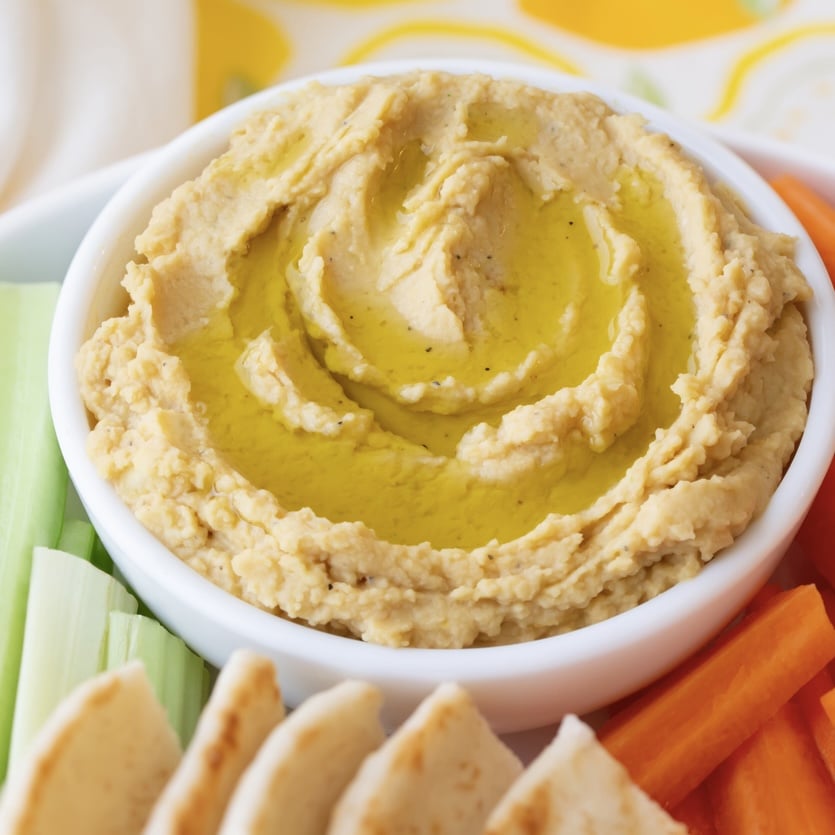
2-tbsp serving has about 2 grams of protein.
Hummus is made from chickpeas, which don’t have as much protein as other items on this list but still make a great snack. Humus typically contains tahini (sesame seed paste) and olive oil, which provide healthy fats that contribute to a feeling of fullness.
This versatile dip can be paired with fresh vegetables like carrot, cucumber, or bell pepper sticks or enjoyed with whole-grain crackers.
Nut Butter on Whole Grain Crackers
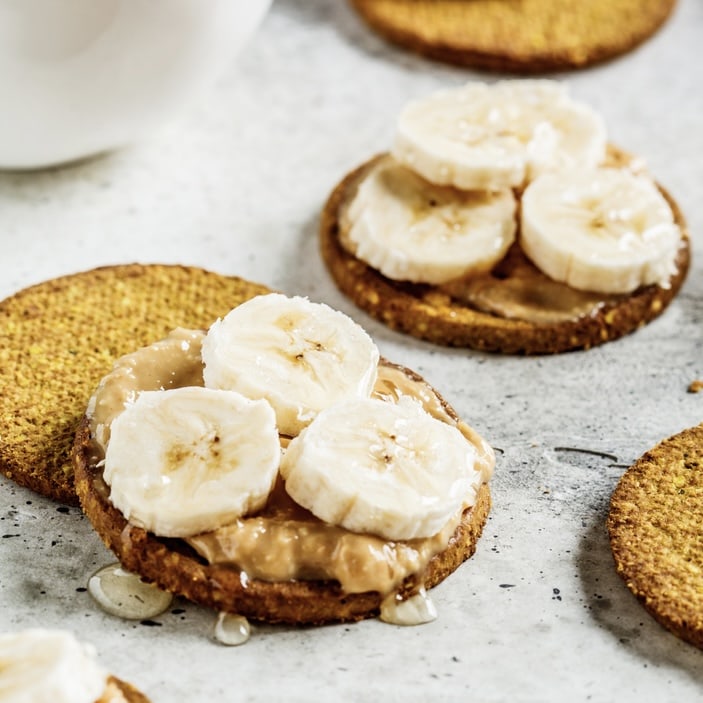
Peanut butter contains 8 grams of protein per 2-tbsp serving. Almond butter contains 7 grams of protein per 2-tbsp serving.
Nut butter, like almond butter, peanut butter, and cashew butter, is rich in healthy fats, protein, fiber, vitamins (such as E and B), and minerals. Nut butters are calorie-dense, so a little can go a long way to satisfying a little person’s hunger. Choose varieties with minimal added sugars, salt, and unhealthy additives to keep this snack healthy. You can learn more about the protein levels in different Nut Butter here if your intetested.
- Artisana Organics Raw Almond Butter
- Justin’s Classic Almond Butter
- Back to Nature Multigrain Flax Seeded Flatbread Crackers
- Breton’s Herb & Garlic Gluten-Free Crackers
Trail Mix with Nuts and Seeds

A one-cup serving of trail mix has about 21 grams of protein.
Trail mix can be a yummy and nutritious snack, depending on its ingredients. Most trail mixes typically consist of a mixture of several high-protein ingredients like nuts and seeds. They usually contain some other ingredients like dried fruits, granola, and chocolate chips.
There are plenty of combination options to choose from when it comes to this snack, or you can create your own custom blend with a mix of nuts, seeds, and dried fruit for a protein-packed snack.
Chickpea Pops
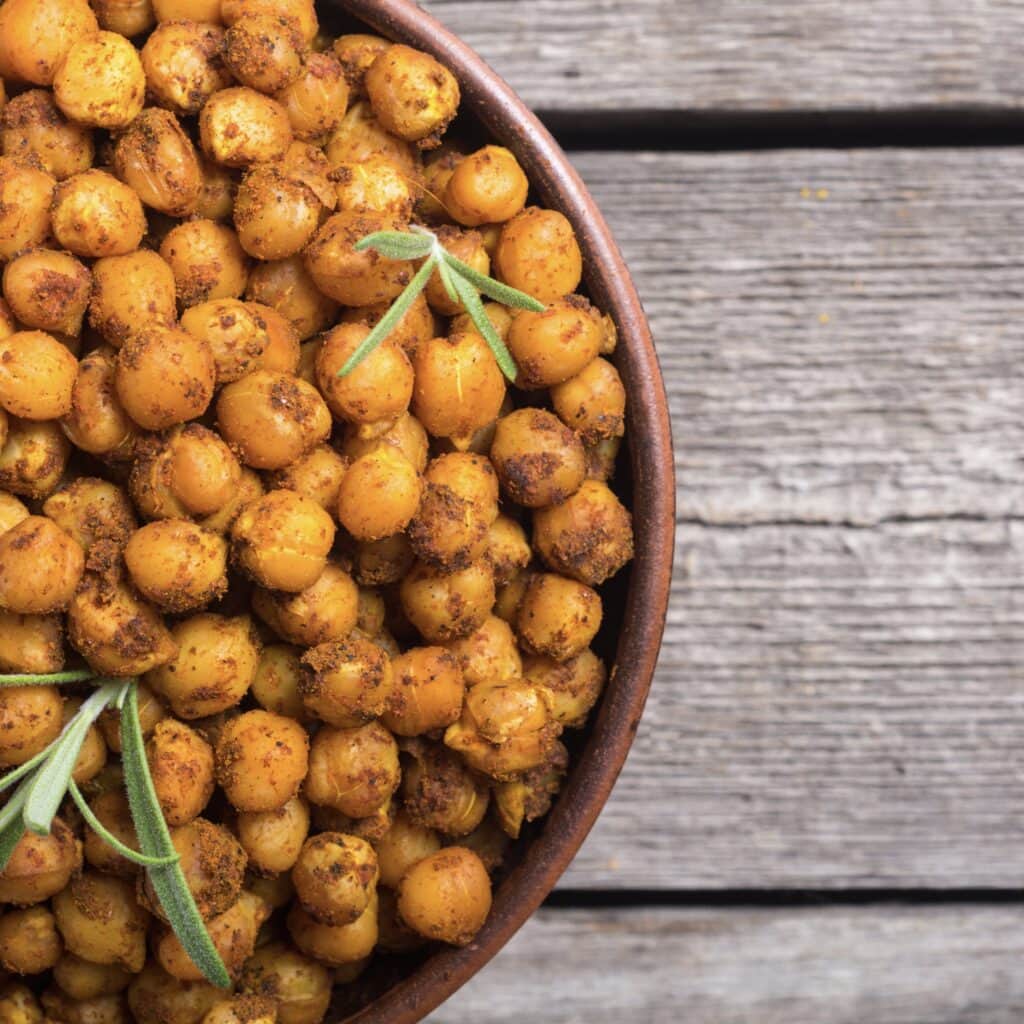
One cup of cooked chickpeas provides about 14.5 grams of protein.
I can’t say I fully understand it, but chickpeas are one of my son’s favorite protein-packed snacks. Also known as garbanzo beans, they are nutrient-dense and a good vegetarian protein that provides several health benefits. Roasting chickpeas enhances their flavor and creates a crunchy texture. You can easily make these healthy snacks at home, and it’s easy enough for the kids to help. Here’s a great recipe to try!
Roast chickpeas with a bit of olive oil and seasoning for a crunchy and protein-rich snack.
Vegetarian Quesadillas
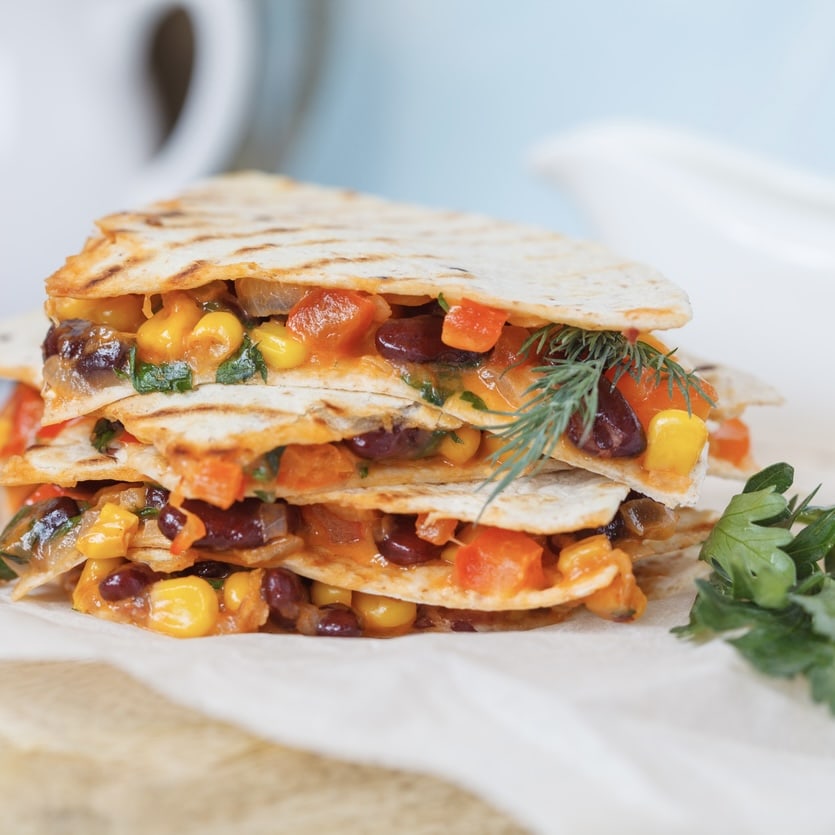
Each cheese quesadilla contains about 24 grams of protein.
Quesadillas with whole wheat tortillas are a great option for an afternoon snack that even picky eaters are sure to enjoy. Cheese provides protein, and you can fill it with a variety of vegetables, such as bell peppers, onions, tomatoes, spinach, or mushrooms, to provide essential vitamins, minerals, and fiber.
Peanut Butter Banana Roll-Ups
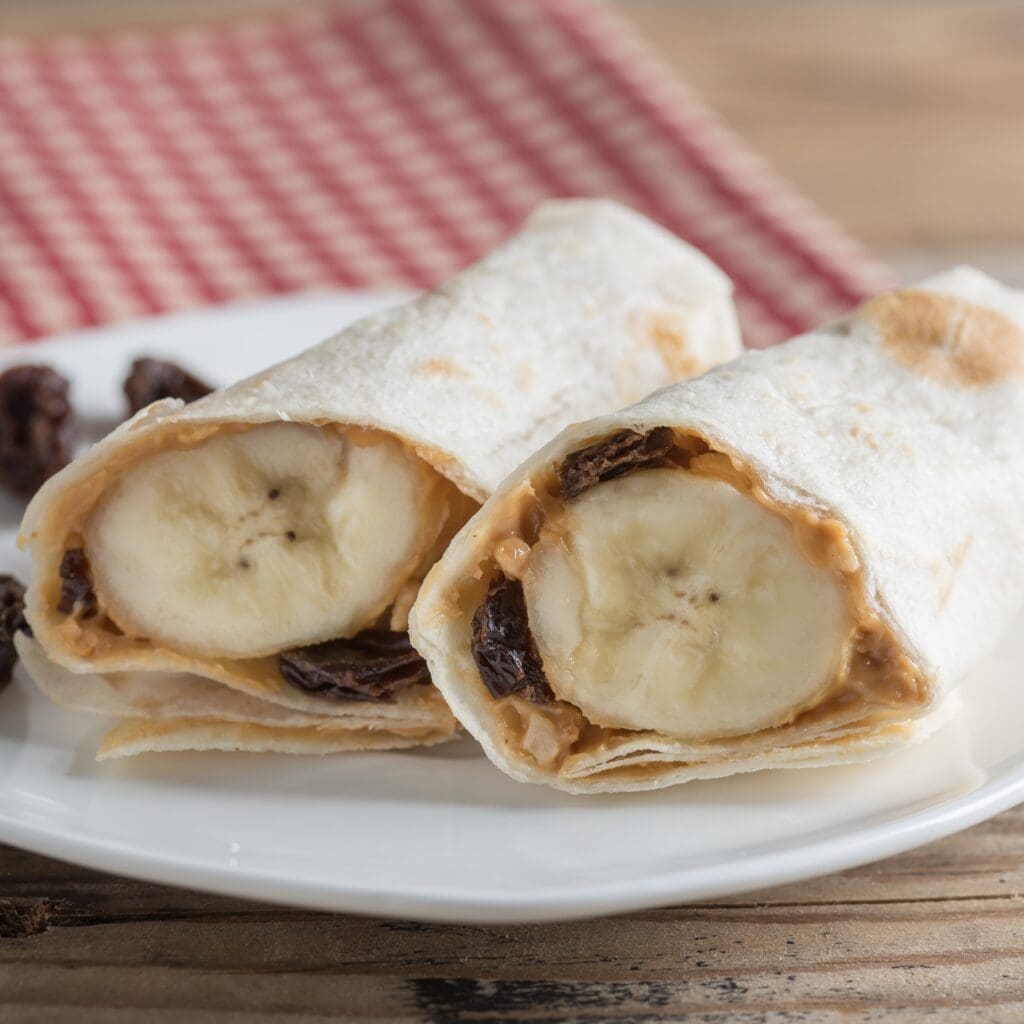
Two tablespoons of Peanut Butter contain 8 grams of protein.
This snack combines the natural goodness of peanut butter, the potassium-rich sweetness of bananas, and the potential addition of whole-grain tortillas for extra fiber. Peanut Butter Banana Roll-Ups are simple to make, making them a quick and convenient snack option for on-the-go or when you need a satisfying treat without much preparation time.
To make these yummy roll-ups, spread peanut butter on a whole-grain tortilla, add banana slices, and roll it up for a protein-rich wrap. For added flavor and nutrients, consider adding a sprinkle of chia seeds or a drizzle of honey.
Roasted Pumpkin Seeds (Pepitas)
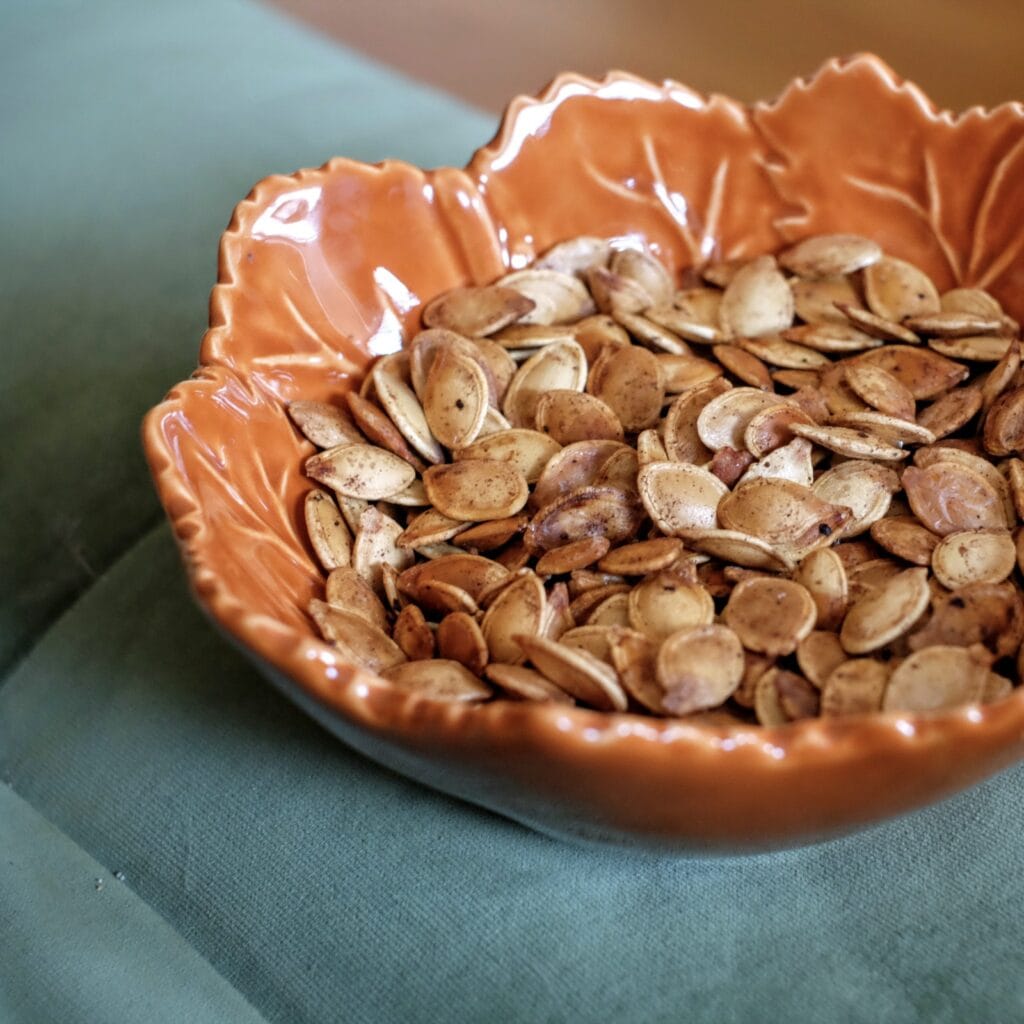
1/4 cup of pumpkin seeds contains about 9 grams of protein.
Roasted pumpkin seeds, aka Pepitas, are rich in antioxidants, iron, zinc, magnesium, and many other nutrients and can be a flavorful and satisfying addition to your little one’s diet. Pumpkin seeds are a plant-based source of protein, making them an excellent option for individuals, including vegetarians and vegans, looking to meet their protein needs.
Roasting pumpkin seeds at home in the oven is super easy, but here are 3 recipes to try that will also explain exactly how to do it.
Crispy Baked Tofu Bites
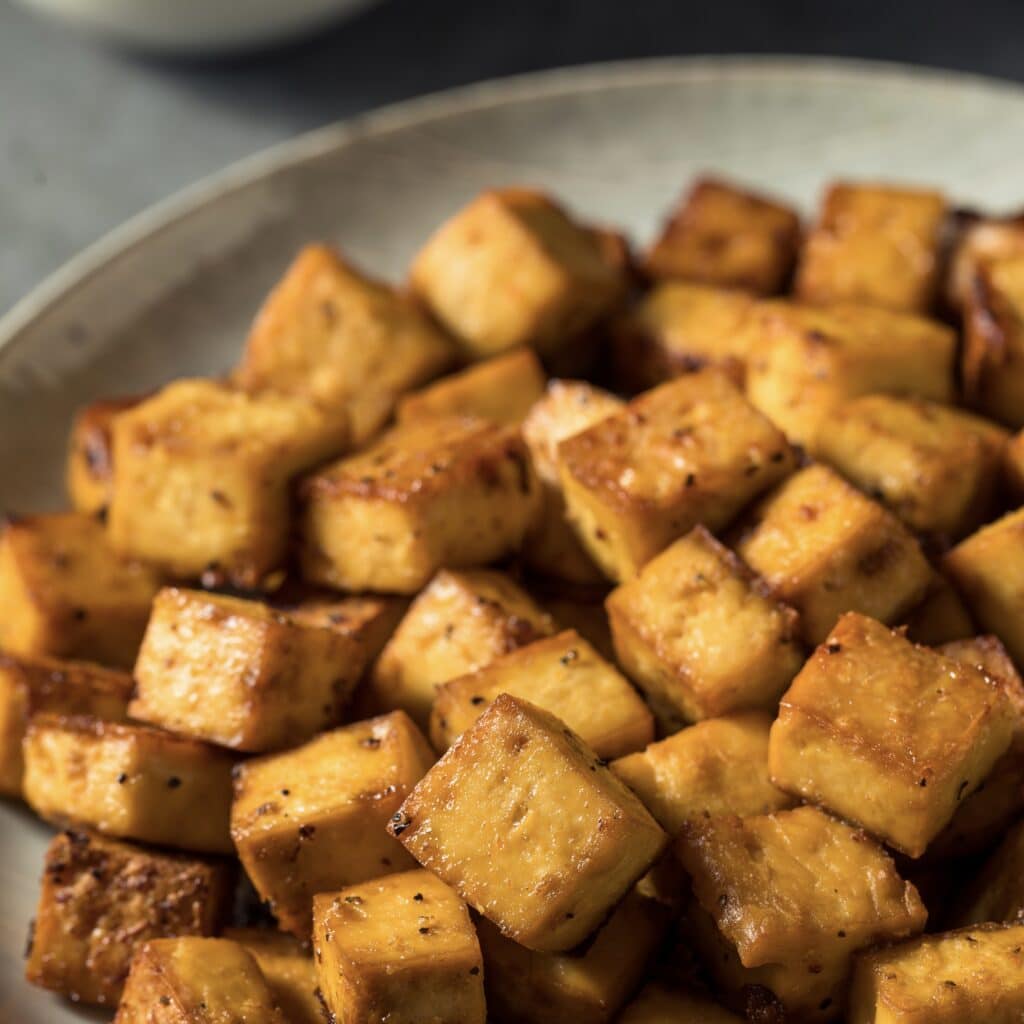
A 3-ounce serving of tofu provides 8 grams of protein.
Tofu is a plant-based protein that offers several health benefits, and baking instead of frying can reduce the overall calorie and fat content. One of the best things about tofu is its ability to be flavored in various ways, allowing you to create crispy baked tofu bites with different seasonings for added taste and variety.
Cube tofu, toss it in your favorite seasonings, and bake until crispy for a tasty, protein-packed snack.
Veggie and Cheese Skewers
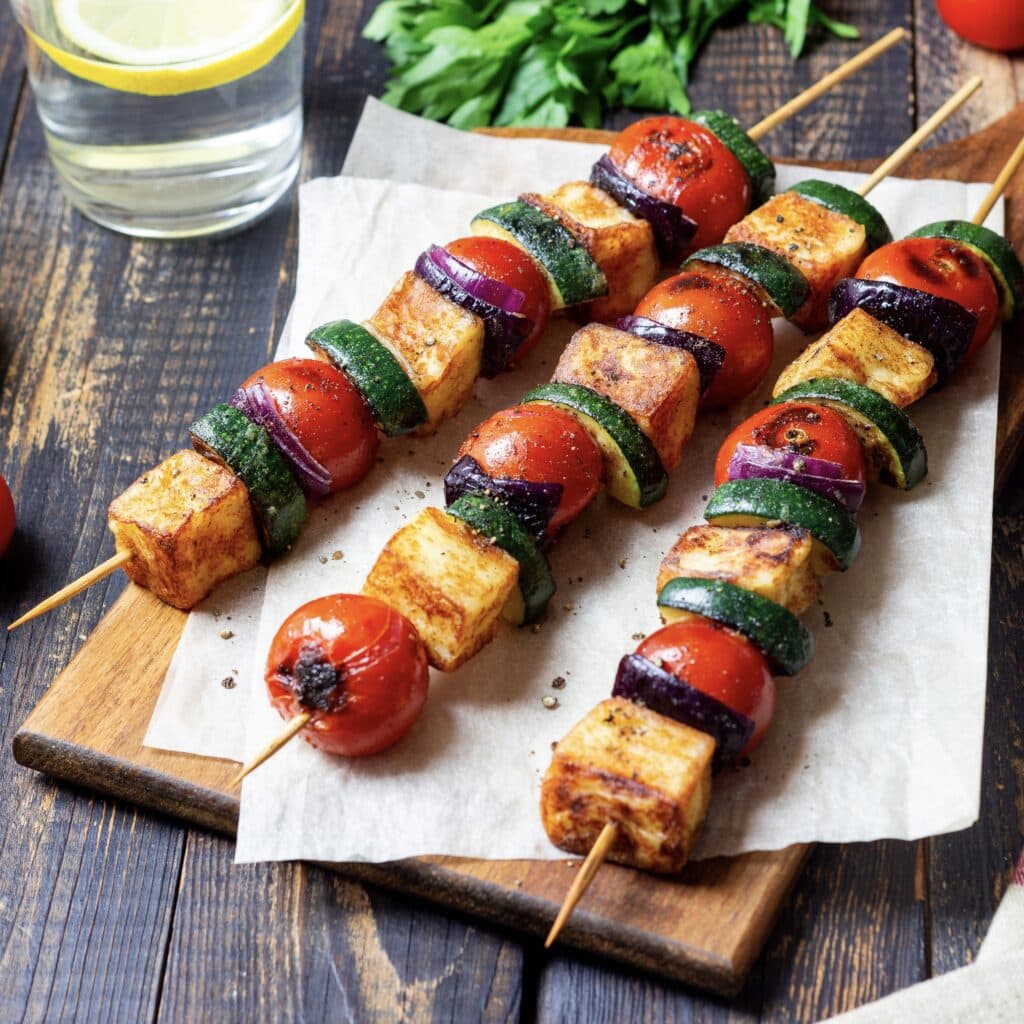
Veggie and cheese skewers are the perfect healthy summer snack. They’re easy to assemble and travel well for a day spent at the beach or park. This snack combines vegetables and cheese, providing a mix of vitamins, minerals, protein, and fiber.
I like to thread cherry tomatoes, cucumber slices, olives, marinated tofu, and cheese cubes onto skewers for a fun and protein-rich snack my kids enjoy.
Quinoa Salad Cups
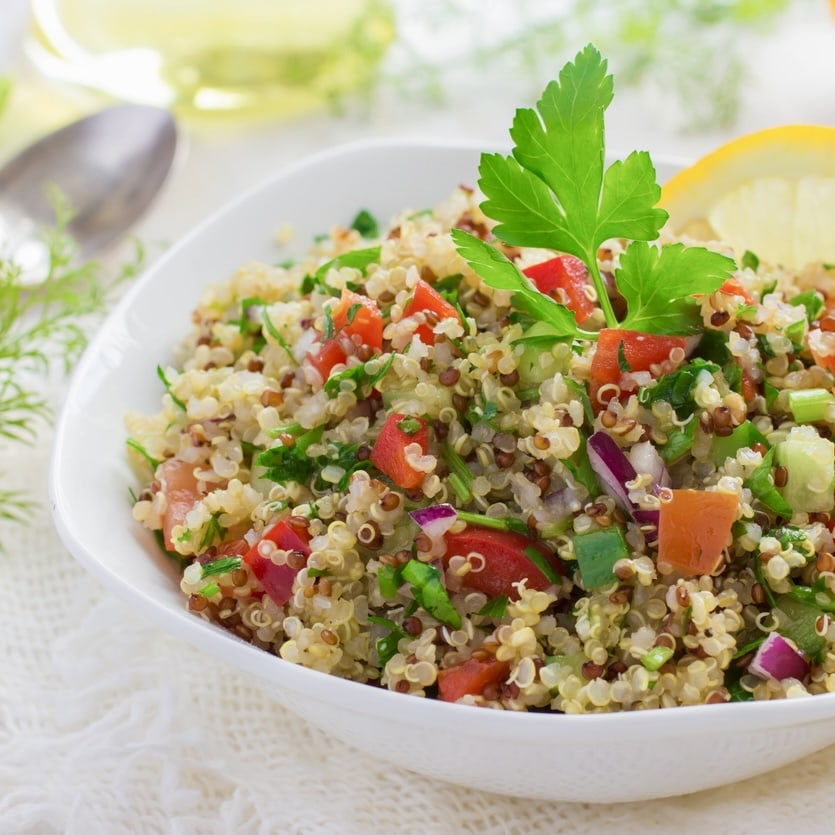
One cup cooked provides about 8 grams of protein
Although technically a seed, Quinoa is classified as a whole grain and is a complete protein containing all essential amino acids. It also contains fiber and various vitamins and minerals. Combined with various colorful vegetables and flavorful dressings, it creates a satisfying and healthful snack option. Quinoa salad cups can be prepared in advance and are easily portable, making them a convenient option for on-the-go snacking.
Mix cooked quinoa with finely chopped veggies like cherry tomatoes, bell peppers, and cucumbers, and serve in small cups for a nutritious snack. Choose dressings with minimal added sugars and unhealthy fats. For a healthier option, consider making your own dressings with olive oil, lemon juice, herbs, and spices.
Sweet Potato And Black Bean Dip
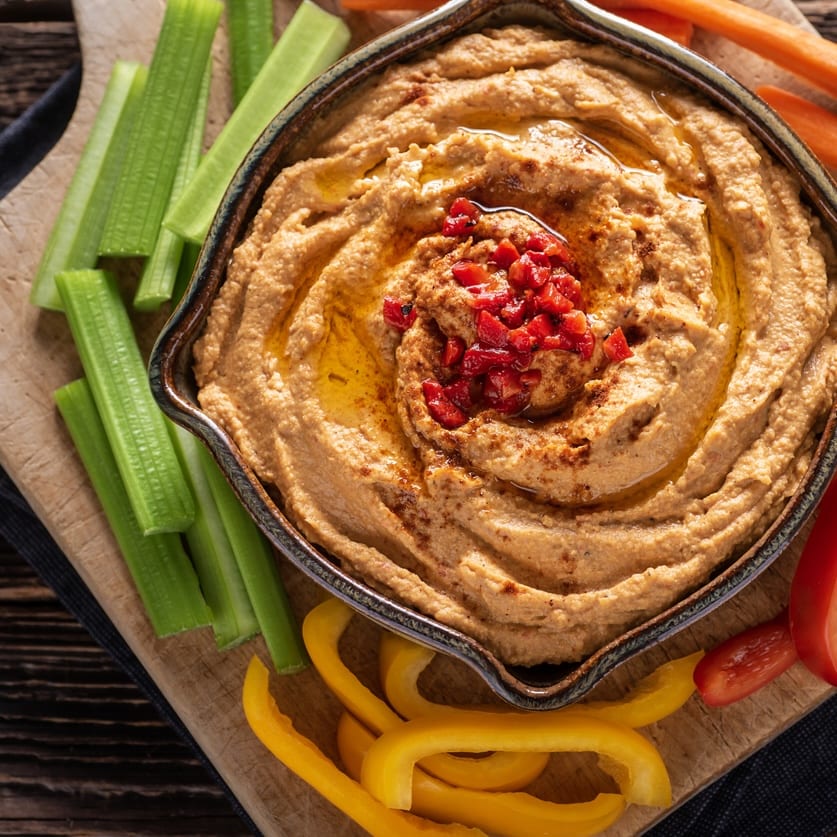
Sweet Potato and Black Bean Dip is a flavorful and nutritious option that combines the richness of sweet potatoes with the protein and fiber of black beans. Here’s a simple recipe for Sweet Potato and Black Bean Dip. Adjust the ingredients and seasonings to suit your taste preferences.
Ingredients:
- 1 large sweet potato, peeled and cubed
- 1 can (15 oz) black beans, drained and rinsed
- 2 cloves garlic, minced
- 2 tablespoons olive oil
- 1 teaspoon ground cumin
- 1 teaspoon chili powder
- Salt and pepper to taste
- Juice of 1 lime
- 2 tablespoons fresh cilantro, chopped (optional)
- Tortilla chips or vegetable sticks for serving
Instructions:
1. Preheat the Oven
Preheat the oven to 400°F (200°C).
2. Roast the Sweet Potatoes
Toss the cubed sweet potatoes with 1 tablespoon of olive oil, salt, and pepper. Spread the sweet potatoes on a baking sheet and roast in the preheated oven for about 20-25 minutes or until they are tender and lightly browned.
3. Prepare the Black Beans
Heat the remaining 1 tablespoon of olive oil in a saucepan. Add minced garlic and sauté for about 1 minute until fragrant. Add the black beans, ground cumin, chili powder, and a pinch of salt. Cook for another 5-7 minutes until the beans are heated through and the flavors meld.
4. Blend the Dip
In a food processor, combine the roasted sweet potatoes, black bean mixture, lime juice, and cilantro (if using). Blend until smooth and creamy. If the dip is too thick, you can add a bit of water or more lime juice to reach your desired consistency.
5. Adjust Seasoning
Taste the dip and adjust the seasoning with salt, pepper, or additional spices as needed.
6. Serve
Transfer the Sweet Potato and Black Bean Dip to a serving bowl and serve with tortilla chips or vegetable sticks for dipping.
Greek Yogurt Parfait Popsicles
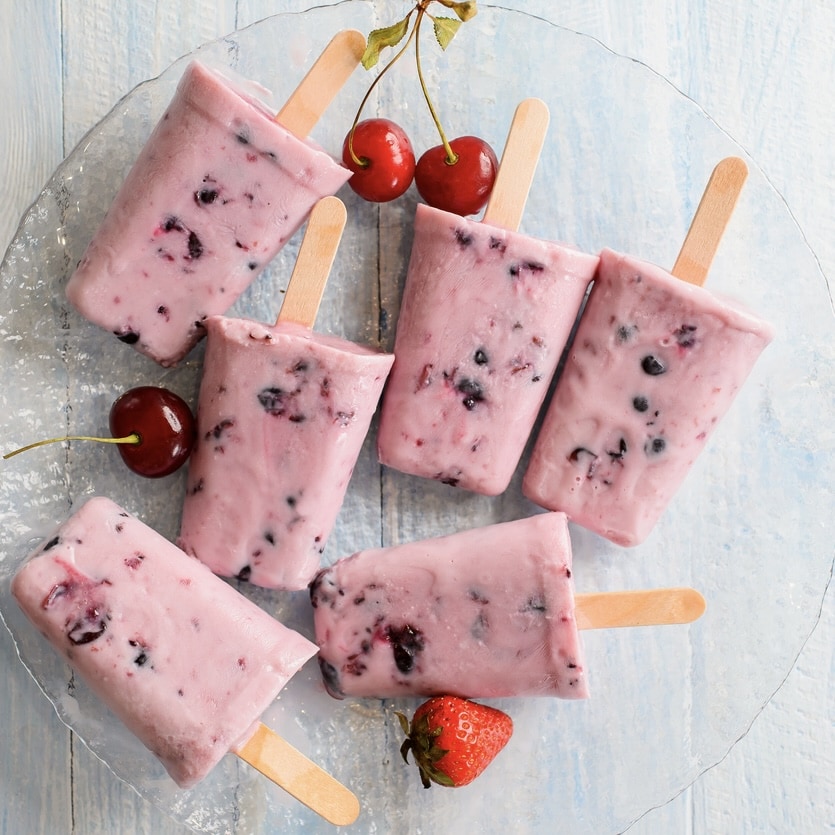
One serving of Greek Yogurt has around 15 grams of protein.
Try these Greek Yogurt Parfait Popsicles for a refreshing and cooling snack during the summer. I think it’s safe to say they’re the yummiest way to ensure plenty of protein during the day. You can customize your popsicle flavors by adding different fruits and berries. This will also introduce a variety of vitamins, antioxidants, and natural sweetness.
Layer Greek yogurt with fruit and granola (optional) in popsicle molds and freeze for a refreshing and protein-rich treat.
Apple Slices With Almond Butter
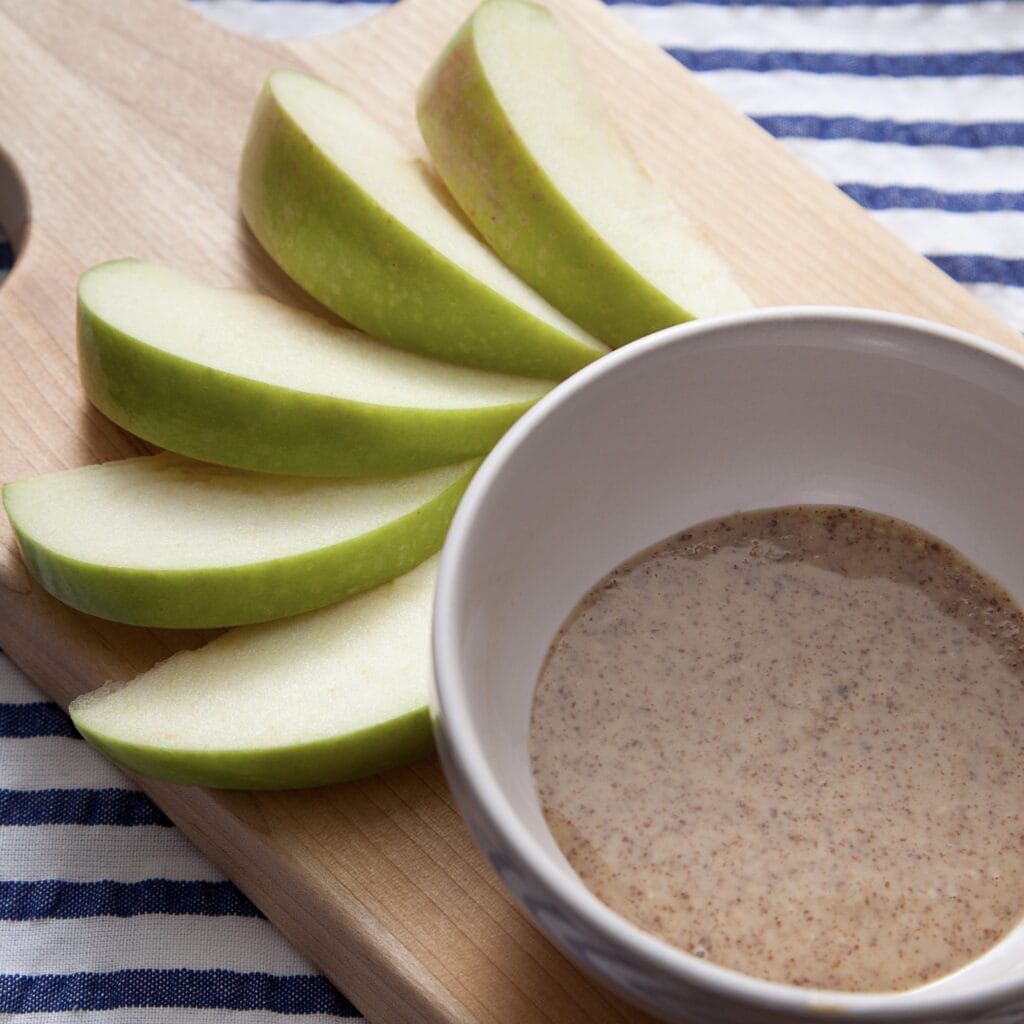
2 tbsp of almond butter has 6.8 grams of protein.
The natural sweetness of apples and the creamy texture of almond butter make this snack appealing to young children. Simply spread almond butter on apple slices for a satisfying protein-rich but sweet combination. It’s also convenient and portable, making it easy to incorporate into school lunches or as an after-school treat.
Consider alternative spreads like sunflower seed butter if nut allergies or dietary restrictions exist.
Whole Grain Toast With Avocado

Approximately 4.2 grams of protein per serving.
This one is a weekly favorite in my house, either for breakfast or a mid-day snack.
Top whole-grain toast with sliced or mashed avocado. You can customize this snack with additional toppings or seasonings, such as a sprinkle of salt, pepper, red pepper flakes, or a drizzle of olive oil. I also like to add micro sprouts or arugula on top.
Cottage Cheese With Pineapple
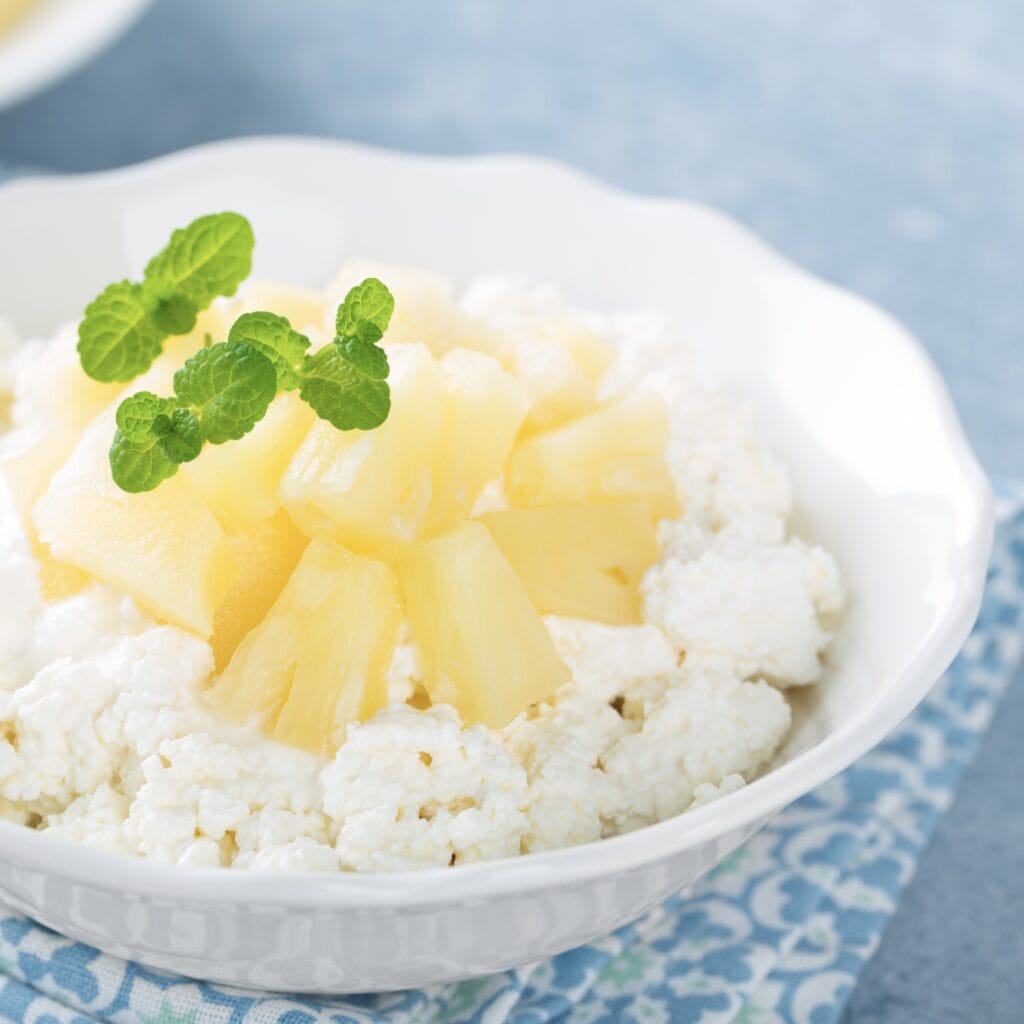
One cup of Cottage cheese contains 25 grams of protein.
Cottage cheese is a great source of protein and calcium, which is important for bone and teeth growth and development in children. Pairing it with pineapple’s natural sweetness makes the snack appealing to kids without the need for added sugars. The amount of protein you can get from these simple ingredients is incredible!
If there are concerns about lactose intolerance or dairy allergies, choose lactose-free cottage cheese or alternative dairy-free options.
Chia Seed Pudding
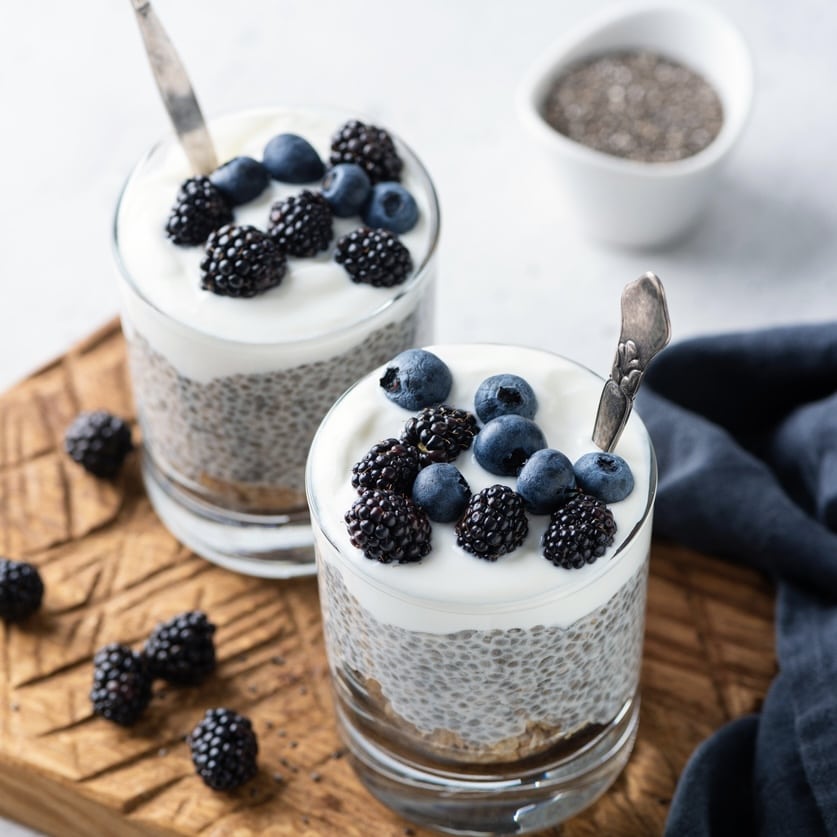
Chia seed pudding has a unique texture that many kids find interesting and enjoyable, adding variety to their snack options. It’s also a convenient and easy-to-prepare snack that can be made ahead of time and stored in the refrigerator. It offers a combination of essential nutrients, making it a healthy and satisfying option for kids.
I like to make chia seed pudding in the evening and let it sit in the refrigerator overnight. An easy way to get some extra protein is to add a protein powder to the milk before putting it in the fridge to sit.
Chia seed pudding is really easy to make, but here is a protein-packed recipe from Eating Bird Food for you to try.
Sunflower Seed Butter on Rice Cakes
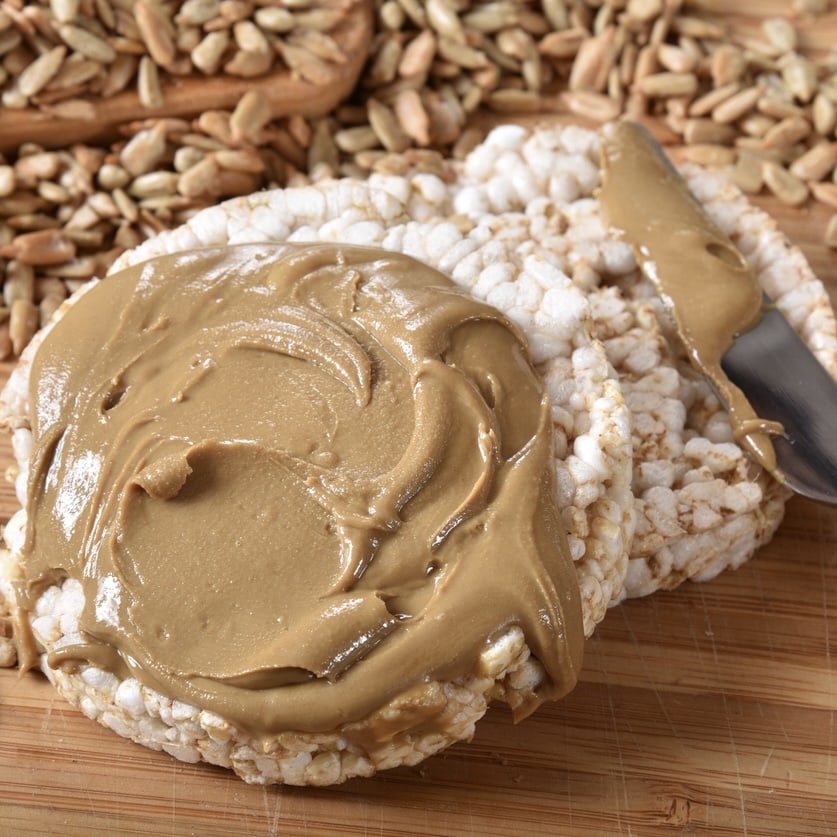
A one-tablespoon serving of sunflower seed butter provides 2.8 grams of protein
Sunflower seed butter, which is made from, you guessed it, sunflower seeds, when spread on rice cakes, offers a combination of healthy fats, protein, and whole grains, making it a well-rounded and satisfying snack. You can customize this snack by adding sliced fruits such as bananas, apples, or raisins for added flavor.
Choose whole-grain rice cakes for added nutritional benefits. And it’s a good idea to check the sunflower seed butter ingredient list to ensure it doesn’t contain added sugar or unhealthy additives.
Pita Bread With Hummus
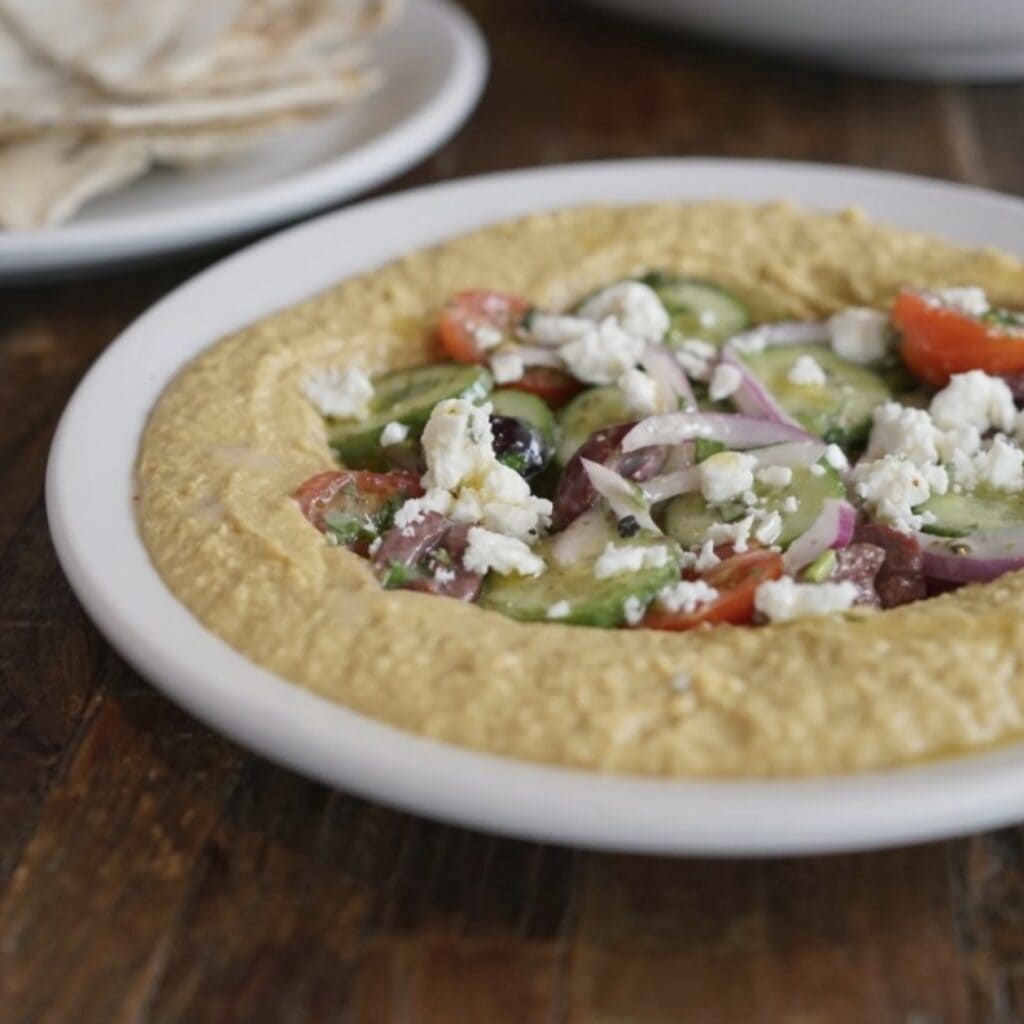
2-tbsp serving has about 2 grams of protein.
Pita bread with hummus is a well-rounded snack that combines whole grains, protein, and healthy fats. Kids often enjoy the interactive aspect of dipping, and hummus is a nutritious and tasty dip option. It can encourage them to eat more veggies or whole grains. Kids can get creative with additional toppings and customize this snack by adding sliced veggies like cucumber, cherry tomatoes, bell peppers, olives, and feta cheese. You can also sneak in some extra veggies by using celery sticks or carrot sticks for dipping.
Choose whole grain pita bread for added nutritional benefits, and opt for homemade or store-bought hummus with minimal added preservatives and artificial ingredients. Below are my favorite store-bought hummus brands.
Bean And Cheese Burritos
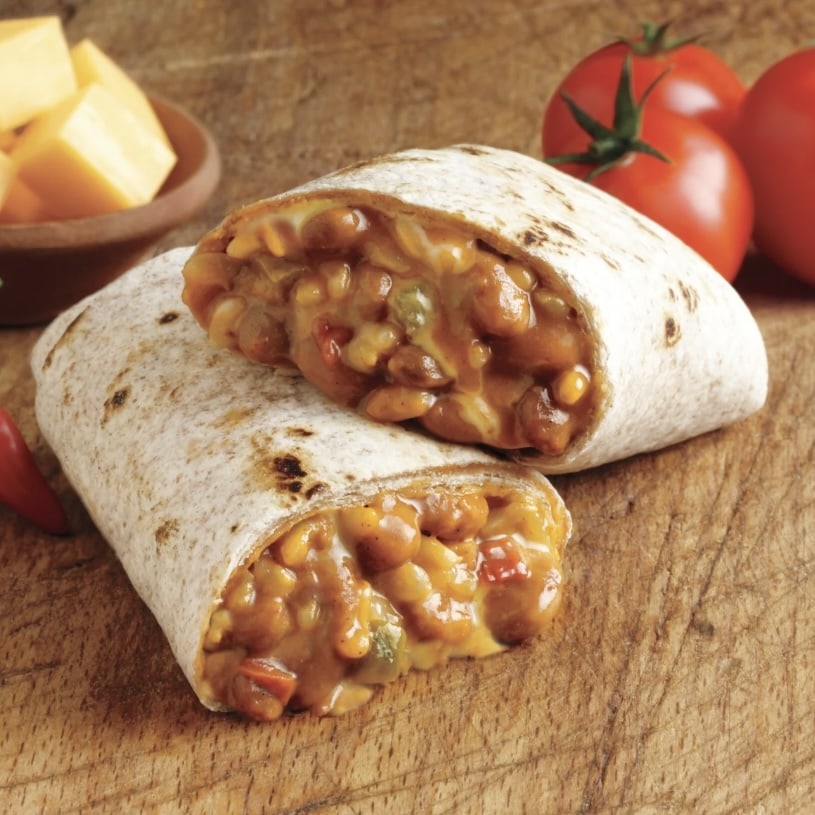
Each Amy’s Bean and Cheddar Cheese Burrito has 11 grams of protein.
Bean and cheese burritos are a nutritious and satisfying meal or snack that balances protein and fiber. Beans also contain important vitamins and minerals such as iron, magnesium, potassium, and folate, making them a great way for your kids to get enough protein for the day.
Homemade burritos are versatile and can be customized with additional ingredients like lettuce, tomatoes, salsa, guacamole, or sour cream for added flavor and nutrition. I always keep a few Amy’s Bean And Cheese Burritos in my freezer at all times.
Cucumber Slices With Cream Cheese
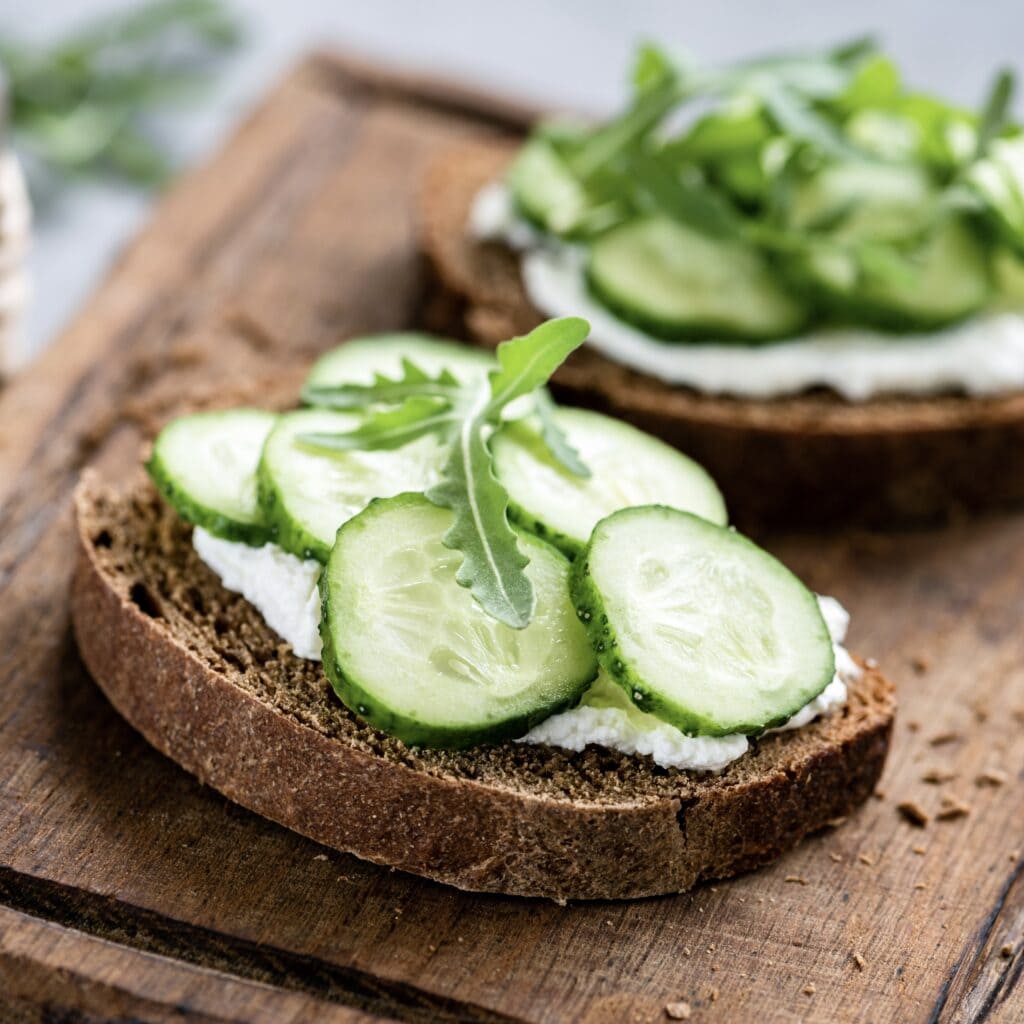
Cucumber slices with cream cheese provide hydration, vitamins, and a satisfying texture. This easy-to-assemble snack can be enjoyed as part of a balanced diet.
You can customize this snack by experimenting with different types of cream cheese, such as flavored varieties, or by adding herbs, spices, or other seasonings to enhance flavor.
Vegetarian Sushi Rolls
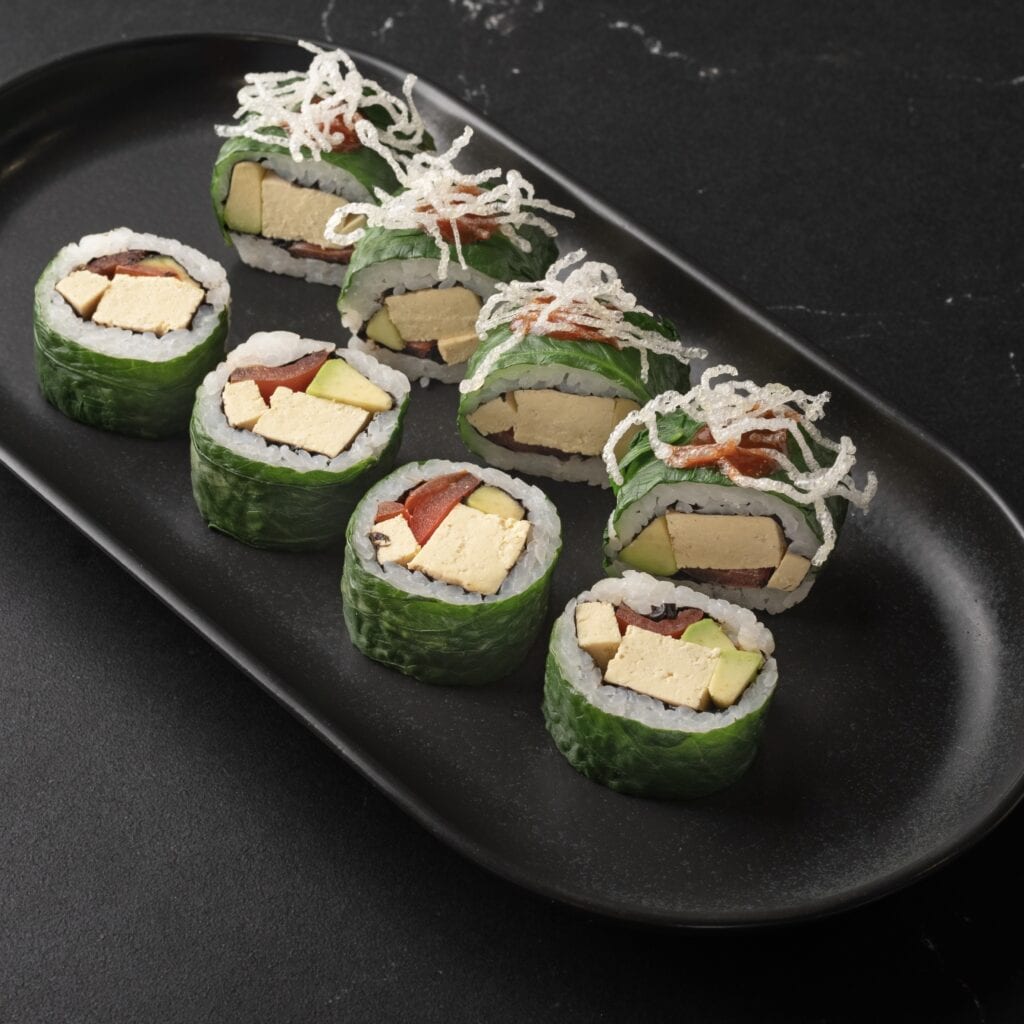
These vegetarian sushi rolls with tofu offer a combination of flavors, textures, and nutrients, making them a tasty and well-rounded snack option for kids. Vegetarian sushi rolls often include vegetables like cucumber, carrots, and seaweed, providing a variety of vitamins (such as vitamin A and vitamin C) and minerals. But if you make it at home, you can customize the ingredients based on your child’s preferences, making it an enjoyable and interactive snack.
We use this little Sushi Making Kit to make sushi at home. It’s a fun way for kids to practice cooking!
Mixed Berry Smoothie
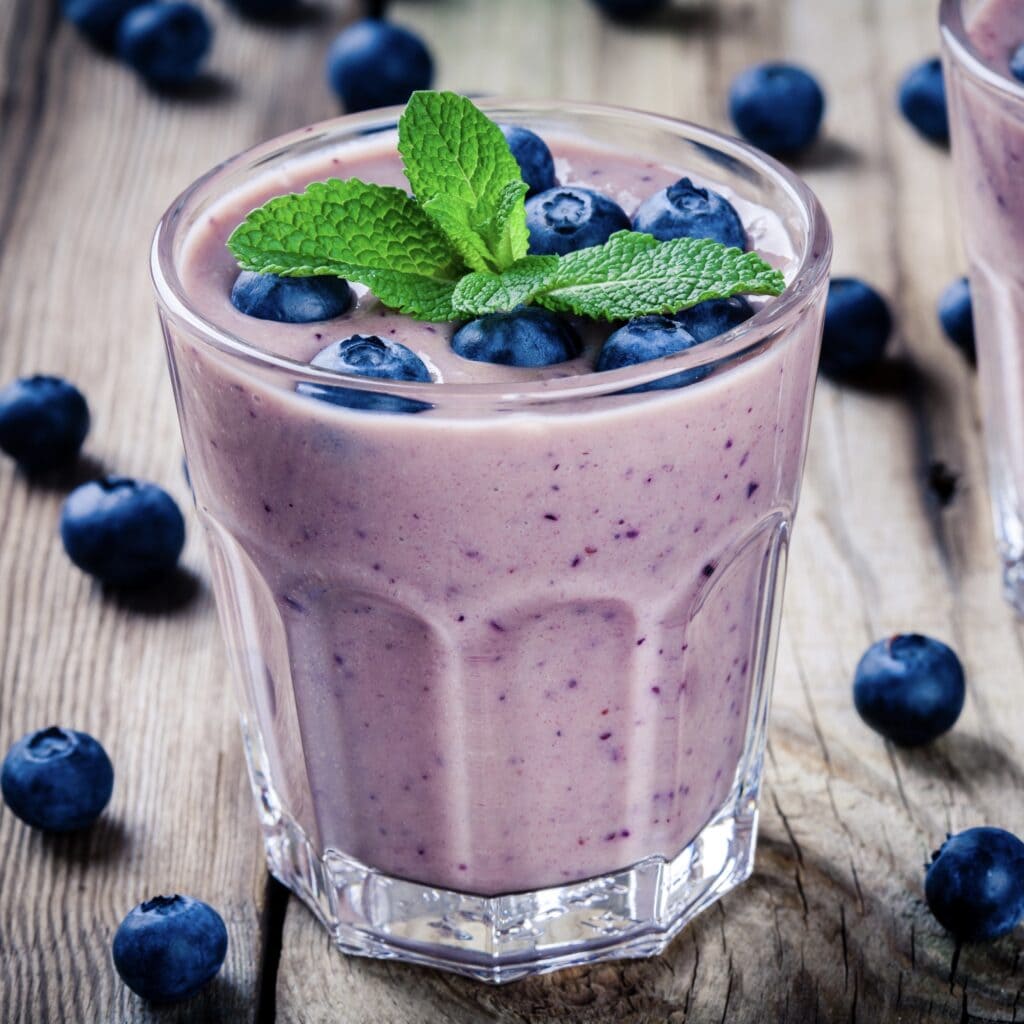
A mixed berry smoothie is a nutritious and delicious way to incorporate a variety of fruits into your snack. It’s a great option for providing essential vitamins, antioxidants, and hydration while satisfying your sweet cravings in a healthy way!
Smoothies are easy and quick to prepare, making them a convenient snack option, especially for those on the go. They can easily be adapted to suit your taste preferences or dietary needs.
Blend mixed berries with Greek yogurt, milk of your choice, or coconut water for a refreshing and protein-rich smoothie. Add protein powder for even more protein. I use the KOS Vegan Protein Powder every day. My kids and I love it! We also sprinkle some hemp seeds, cocoa nibs, and goji berries on top for some extra flavor and crunch.
If your kids love smoothies and fresh juice, you’ll enjoy these two posts, Fresh Juice Recipes and Delicious Juice Recipes For Gut Health
How Much Protein Do Kids Need
Protein is a vital nutrient that plays a crucial role in the structure and function of cells, tissues, and organs within the body and supports growth, development, and overall health. Although a child’s protein needs will vary based on age, gender, and level of physical activity, here’s a general guideline for the recommended daily protein intake for children based on different age groups.
Please note that these are general guidelines, and individual children may have unique nutritional requirements. Parents should consult with pediatricians or registered dietitians for personalized advice based on their child’s specific needs, growth patterns, and dietary preferences.
Infants (0-6 months)
- Recommended Protein Intake: About 9 grams per day.
- Infants primarily obtain their protein from breast milk or formula, which naturally provides the essential amino acids necessary for their growth.
Infants (7-12 months)
- Recommended Protein Intake: Around 11 grams per day.
- As solid foods are introduced, protein from sources like pureed veggies, dairy products, and legumes becomes a more significant part of their diet.
Toddlers (1-3 years)
- Recommended Protein Intake: About 13 grams per day.
- Toddlers are often introduced to a variety of foods, including dairy products, eggs, poultry, and legumes, providing them with essential protein for growth and development.
Preschoolers (4-8 years)
- Recommended Protein Intake: Around 19 grams per day.
- As children become more active, their protein needs increase. Including a mix of protein-rich foods like dairy, nuts, and whole grains is important.
School-age Children (9-13 years)
- Recommended Protein Intake: Approximately 34 grams per day.
- With the onset of puberty and increased physical activity, children in this age group require more protein to support their growth spurts and muscle development.
Quick side note. I know most children include meat in their diet, but I don’t like to write about topics I have no knowledge of. And as a lifelong vegetarian, that includes eating meat.
Conclusion
Incorporating more high-protein, kid-friendly snack recipes into your child’s diet can have numerous benefits, including promoting healthy growth and development, improving concentration and energy levels, and reducing junk food cravings. By choosing options like yogurt, nuts, and hummus, you can easily provide your child with a well-balanced and nutritious snack that will keep them satisfied and energized throughout the day. As the saying goes, “You are what you eat,” and by choosing protein-rich snacks, you are setting your child up for a lifetime of healthy habits.
So next time your child reaches for a snack, remember the power of protein and make a choice that will fuel their mind and body. As the famous chef Julia Child once said, “You don’t have to cook fancy or complicated masterpieces – just good food from fresh ingredients.” Let’s give our kids the fuel they need to thrive. And don’t forget to keep exploring and experimenting with new high protein snack ideas – there’s always room for more healthy and delicious options in the pantry!
Xx Monti


